
19 May 2025
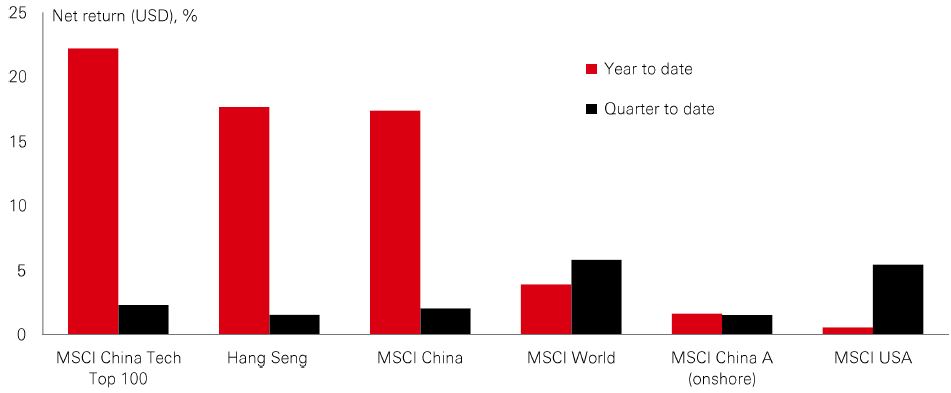
Is it deal-done and crisis-averted in investment markets? Last week’s agreement between the US and China to slash tariffs for at least the next 90 days is the strongest marker yet of a shift to policy de-escalation. In truth, investors have been alert to this theme since the market recovery began in the third week of April. But last week’s price action takes US stocks decisively above their “Liberation Day” levels.
Market price moves naturally reflect a shift in investors’ assessment of the risks: lower probabilities now on bad outcomes, and higher probabilities on better outcomes. Even so, it still looks like average US tariffs will settle in the low teens, the highest rate we’ve seen in the post-war period. Macro damage has already been done. And the policy outlook remains ultra-uncertain. An important theme this year has been the dramatic rotation of the market narrative. The theme has moved from a universal belief in US exceptionalism in January to a US policy induced recession and worries about economic fragmentation in early April. Now it looks like something in-between. Markets will continue to spin-around.
As for China, the US talks followed a new round of policy stimulus – including rate cuts, targeted easing, credit support, and support for financial markets. Chinese offshore indices have performed well in 2025 driven by strong returns in technology stocks, which continue to be a profit engine, with firms capitalising on DeepSeek-driven AI optimism. By contrast, onshore indices have been weaker, due to lower tech exposures and slightly higher valuations.
With the Eurovision Song Contest beaming live from Basel to living rooms around the world last weekend, we bring other news from Europe – but this time on proposed developments in the bond market. Recent questions over the safe-haven status of US Treasuries have been a reminder that investors face limited substitutes given that Europe's fragmented debt markets fail to offer the depth and liquidity necessary to rival Treasuries. Moreover, structural imbalances between eurozone economies cause destabilising capital flows between “core” and “periphery” nations during stress periods.
The proposal for European Safe Bonds (ESBies) offers a potential solution. In technical-speak, ESBies are the senior tranche of a securitisation vehicle backed by a diversified portfolio of eurozone sovereign bonds, with the junior tranche referred to as European Junior Bonds, or EJBies. They would command enhanced safe-haven premiums through cross-European risk pooling – signalling more market cohesion and serving as a risk-free alternative to German Bunds. They could represent a way of increasing systemic resilience, while addressing the global safe asset shortage and over-reliance on the dollar – just as US exceptionalism as the sole provider of safety is under scrutiny.
The value of investments and any income from them can go down as well as up and investors may not get back the amount originally invested. Past performance does not predict future returns. The level of yield is not guaranteed and may rise or fall in the future. For informational purposes only and should not be construed as a recommendation to invest in the specific country, product, strategy, sector, or security. Diversification does not ensure a profit or protect against loss. Any views expressed were held at the time of preparation and are subject to change without notice. Any forecast, projection or target where provided is indicative only and is not guaranteed in any way. Source: HSBC Asset Management, Bloomberg. Data as at 7.30am UK time 16 May 2025.
The past week saw the US and China agree to substantially reduce tariffs for a 90-day period while working towards a deal. Although clearly positive news, the significant changes in tariff policy since early April are likely to make interpreting macro data tricky in the coming months. The lion’s share of survey data – aka “soft data” – for April weakened on the back of “Liberation Day”. But May is likely to see some recovery, especially in the context of resurgent US equities. |
However, it is worth taking a step back and remembering that even after the thawing of US-China trade relations, the average effective US import tariff has still risen to a post-WWII high. Accordingly, macro models suggest US growth will drop well below trend in the coming quarters. Hence, while “soft” data may stage a recovery, “hard” data are likely to weaken, especially given investment and consumer spending was pulled into Q1 to avoid paying tariffs, likely leaving an “air pocket” in Q2. In the absence of further positive policy news, weaker “hard” data could trigger some renewed volatility in risk markets.
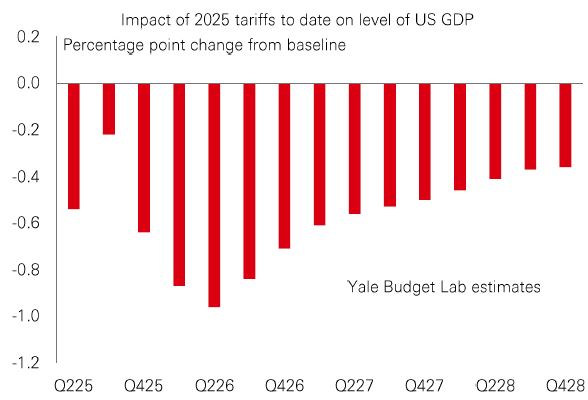
When the US government announced plans for reciprocal tariffs in early April, the initial 46% levy on Vietnam (later cut to 10% while trade talks continue) made it one of the worst affected countries. As a fast-growing Frontier manufacturing hub, Vietnam’s goods trade surplus with the US has soared in recent years (2024: USD123.5 billion). That’s been driven by its popularity with western firms pursuing a “China Plus One” strategy of diversifying their supply chains. Like other Frontier markets, ultra-high trade policy uncertainty has caused volatility in Vietnamese stocks. But the market has rebounded well, and year-to-date Frontiers as a group have returned 8.9%, outperforming both developed (3.7%) and emerging (8.5%) markets. |
This positive performance is down to factors including discounted valuations, strong earnings growth, and local country idiosyncrasies that offer protection against macro pressures. In the case of Vietnam, foreign investment is expected to be sticky despite recent uncertainty, with the country’s expanding middle class, digital adoption, and urbanisation giving its economy structural resilience.
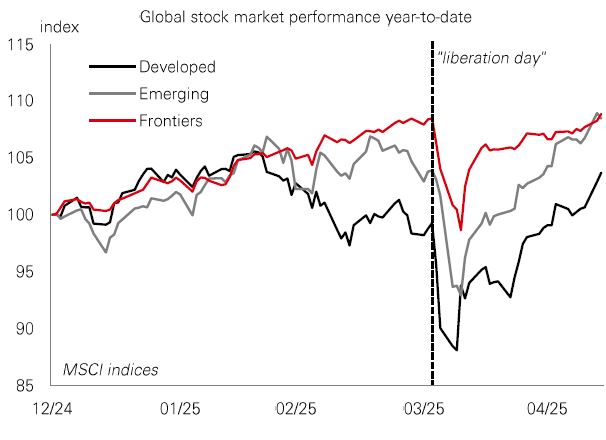
With market rotations continuing, there could be a case for investors to look beyond US large-cap dominance for upside in global small caps. The US S&P 600 small-cap index has lagged the S&P 500 by over 50% over the past decade. And while investors would be forgiven for losing patience by now, history suggests smaller firms can deliver big gains after spells out of favour. Take the 1993-2000 technology bubble. After a serious bout of small-cap neglect, the S&P small-cap index trounced the S&P 500 by 75% from 2001 to 2010. |
Small caps have a high beta to both local growth and borrowing. While 65% of US corporate borrowing comes from capital markets, it’s only 15-20% in Europe, making those firms more reliant on bank financing. Today, many global small-cap indices trade at a discount of close to 20% versus the last decade. Non-US small caps currently trade below their average 12-month forward PEs, with Hong Kong and UK small-cap PEs close to 10x – half the S&P 500’s 20.5x.
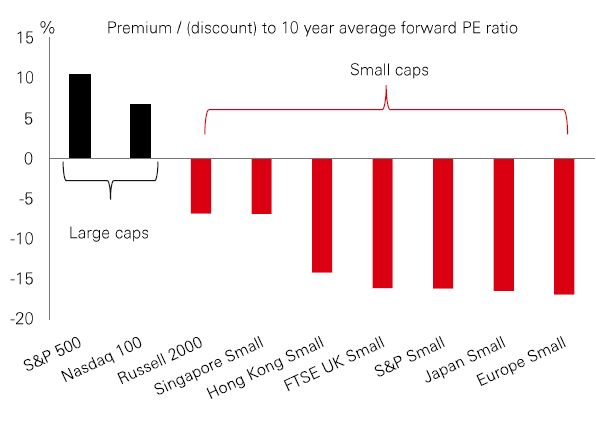
Past performance does not predict future returns. The level of yield is not guaranteed and may rise or fall in the future. For informational purposes only and should not be construed as a recommendation to invest in the specific country, product, strategy, sector, or security. Any views expressed were held at the time of preparation and are subject to change without notice. Index returns assume reinvestment of all distributions and do not reflect fees or expenses. You cannot invest directly in an index. Any forecast, projection or target where provided is indicative only and is not guaranteed in any way. HSBC Asset Management accepts no liability for any failure to meet such forecast, projection or target. Source: HSBC Asset Management. Macrobond, Bloomberg. Data as at 7.30am UK time 16 May 2025.
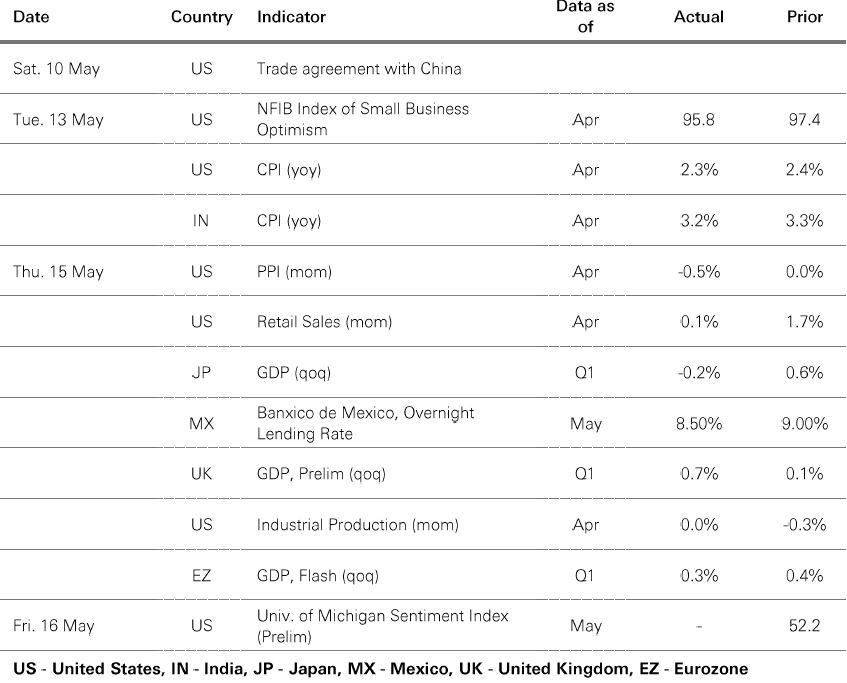
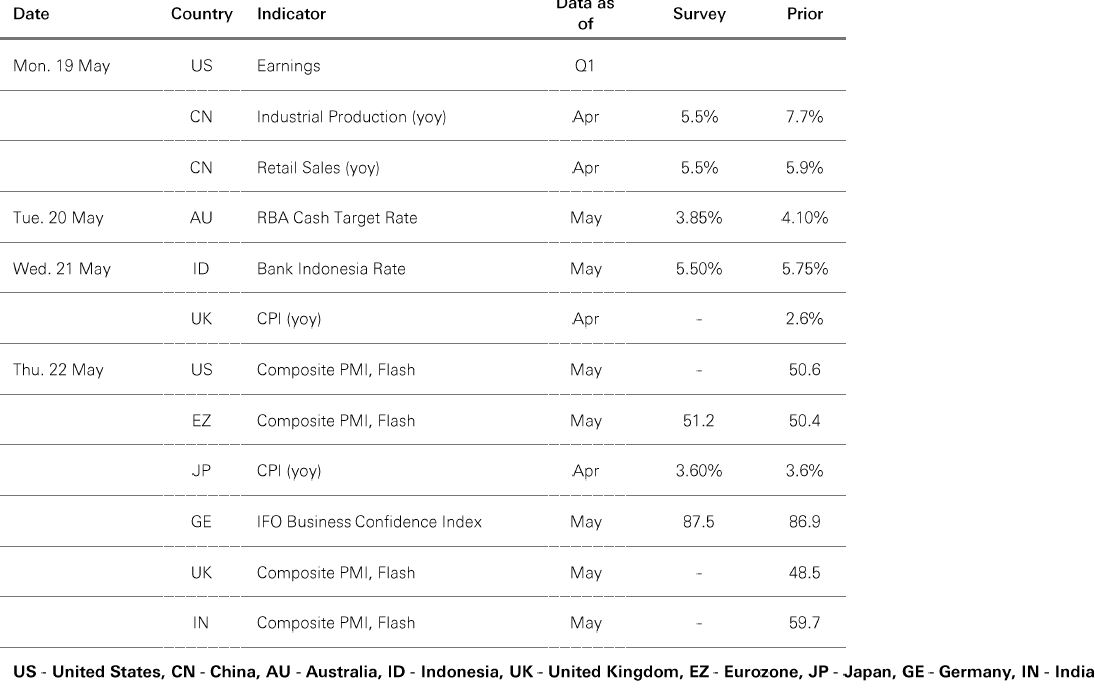
Source: HSBC Asset Management. Data as at 7.30am UK time 16 May 2025. For informational purposes only and should not be construed as a recommendation to invest in the specific country, product, strategy, sector or security. Any views expressed were held at the time of preparation and are subject to change without notice. Any forecast, projection or target where provided is indicative only and is not guaranteed in any way.
Risk-on market sentiment strengthened last week as the US and China agreed to reduce tariffs to 30% on Chinese imports, and 10% on US imports into China for a 90-day period. US markets now anticipate two rate cuts by year-end, down from nearly three the previous week. The US dollar continued its modest recovery, while US Treasuries declined, alongside similar yield rises in German Bunds and UK Gilts. US and eurozone credit spreads narrowed. US equities surged, driven by technology, with European markets following, supported by strong Q1 earnings in financials and healthcare. Japan's Nikkei 225 posted modest gains as the yen were range-bound. Other Asian indices performed well, led by India’s Sensex, followed by Hong Kong’s Hang Seng, China’s Shanghai composite, and South Korea's Kospi. In commodities, oil prices edged higher, whilst gold retreated from previous week’s gains.





This document or video is prepared by The Hongkong and Shanghai Banking Corporation Limited (‘HBAP’), 1 Queen’s Road Central, Hong Kong. HBAP is incorporated in Hong Kong and is part of the HSBC Group. This document or video is distributed and/or made available, HSBC Bank (China) Company Limited, HSBC Bank (Singapore) Limited, HSBC Bank Middle East Limited (UAE), HSBC UK Bank Plc, HSBC Bank Malaysia Berhad (198401015221 (127776-V))/HSBC Amanah Malaysia Berhad (20080100642 1 (807705-X)), HSBC Bank (Taiwan) Limited, HSBC Bank plc, Jersey Branch, HSBC Bank plc, Guernsey Branch, HSBC Bank plc in the Isle of Man, HSBC Continental Europe, Greece, The Hongkong and Shanghai Banking Corporation Limited, India (HSBC India), HSBC Bank (Vietnam) Limited, PT Bank HSBC Indonesia (HBID), HSBC Bank (Uruguay) S.A. (HSBC Uruguay is authorised and oversought by Banco Central del Uruguay), HBAP Sri Lanka Branch, The Hongkong and Shanghai Banking Corporation Limited – Philippine Branch, HSBC Investment and Insurance Brokerage, Philippines Inc, and HSBC FinTech Services (Shanghai) Company Limited and HSBC Mexico, S.A. Multiple Banking Institution HSBC Financial Group (collectively, the “Distributors”) to their respective clients. This document or video is for general circulation and information purposes only.
The contents of this document or video may not be reproduced or further distributed to any person or entity, whether in whole or in part, for any purpose. This document or video must not be distributed in any jurisdiction where its distribution is unlawful. All non-authorised reproduction or use of this document or video will be the responsibility of the user and may lead to legal proceedings. The material contained in this document or video is for general information purposes only and does not constitute investment research or advice or a recommendation to buy or sell investments. Some of the statements contained in this document or video may be considered forward looking statements which provide current expectations or forecasts of future events. Such forward looking statements are not guarantees of future performance or events and involve risks and uncertainties. Actual results may differ materially from those described in such forward-looking statements as a result of various factors. HBAP and the Distributors do not undertake any obligation to update the forward-looking statements contained herein, or to update the reasons why actual results could differ from those projected in the forward-looking statements. This document or video has no contractual value and is not by any means intended as a solicitation, nor a recommendation for the purchase or sale of any financial instrument in any jurisdiction in which such an offer is not lawful. The views and opinions expressed are based on the HSBC Global Investment Committee at the time of preparation and are subject to change at any time. These views may not necessarily indicate HSBC Asset Management‘s current portfolios’ composition. Individual portfolios managed by HSBC Asset Management primarily reflect individual clients’ objectives, risk preferences, time horizon, and market liquidity.
The value of investments and the income from them can go down as well as up and investors may not get back the amount originally invested. Past performance contained in this document or video is not a reliable indicator of future performance whilst any forecasts, projections and simulations contained herein should not be relied upon as an indication of future results. Where overseas investments are held the rate of currency exchange may cause the value of such investments to go down as well as up. Investments in emerging markets are by their nature higher risk and potentially more volatile than those inherent in some established markets. Economies in emerging markets generally are heavily dependent upon international trade and, accordingly, have been and may continue to be affected adversely by trade barriers, exchange controls, managed adjustments in relative currency values and other protectionist measures imposed or negotiated by the countries with which they trade. These economies also have been and may continue to be affected adversely by economic conditions in the countries in which they trade. Investments are subject to market risks, read all investment related documents carefully.
This document or video provides a high-level overview of the recent economic environment and has been prepared for information purposes only. The views presented are those of HBAP and are based on HBAP’s global views and may not necessarily align with the Distributors’ local views. It has not been prepared in accordance with legal requirements designed to promote the independence of investment research and is not subject to any prohibition on dealing ahead of its dissemination. It is not intended to provide and should not be relied on for accounting, legal or tax advice. Before you make any investment decision, you may wish to consult an independent financial adviser. In the event that you choose not to seek advice from a financial adviser, you should carefully consider whether the investment product is suitable for you. You are advised to obtain appropriate professional advice where necessary.
The accuracy and/or completeness of any third-party information obtained from sources which we believe to be reliable might have not been independently verified, hence Customer must seek from several sources prior to making investment decision.
The following statement is only applicable to HSBC Mexico, S.A. Multiple Banking Institution HSBC Financial Group with regard to how the publication is distributed to its customers: This publication is distributed by Wealth Insights of HSBC México, and its objective is for informational purposes only and should not be interpreted as an offer or invitation to buy or sell any security related to financial instruments, investments or other financial product. This communication is not intended to contain an exhaustive description of the considerations that may be important in making a decision to make any change and/or modification to any product, and what is contained or reflected in this report does not constitute, and is not intended to constitute, nor should it be construed as advice, investment advice or a recommendation, offer or solicitation to buy or sell any service, product, security, merchandise, currency or any other asset.
Receiving parties should not consider this document as a substitute for their own judgment. The past performance of the securities or financial instruments mentioned herein is not necessarily indicative of future results. All information, as well as prices indicated, are subject to change without prior notice; Wealth Insights of HSBC Mexico is not obliged to update or keep it current or to give any notification in the event that the information presented here undergoes any update or change. The securities and investment products described herein may not be suitable for sale in all jurisdictions or may not be suitable for some categories of investors.
The information contained in this communication is derived from a variety of sources deemed reliable; however, its accuracy or completeness cannot be guaranteed. HSBC México will not be responsible for any loss or damage of any kind that may arise from transmission errors, inaccuracies, omissions, changes in market factors or conditions, or any other circumstance beyond the control of HSBC. Different HSBC legal entities may carry out distribution of Wealth Insights internationally in accordance with local regulatory requirements.
Important Information about the Hongkong and Shanghai Banking Corporation Limited, India (“HSBC India”)
HSBC India is a branch of The Hongkong and Shanghai Banking Corporation Limited. HSBC India is a distributor of mutual funds and referrer of investment products from third party entities registered and regulated in India. HSBC India does not distribute investment products to those persons who are either the citizens or residents of United States of America (USA), Canada or New Zealand or any other jurisdiction where such distribution would be contrary to law or regulation.
The following statement is only applicable to HSBC Bank (Taiwan) Limited with regard to how the publication is distributed to its customers: HSBC Bank (Taiwan) Limited (“the Bank”) shall fulfill the fiduciary duty act as a reasonable person once in exercising offering/conducting ordinary care in offering trust services/ business. However, the Bank disclaims any guarantee on the management or operation performance of the trust business.
The following statement is only applicable to PT Bank HSBC Indonesia (“HBID”): PT Bank HSBC Indonesia (“HBID”) is licensed and supervised by Indonesia Financial Services Authority (“OJK”). Customer must understand that historical performance does not guarantee future performance. Investment product that are offered in HBID is third party products, HBID is a selling agent for third party product such as Mutual Fund and Bonds. HBID and HSBC Group (HSBC Holdings Plc and its subsidiaries and associates company or any of its branches) does not guarantee the underlying investment, principal or return on customer investment. Investment in Mutual Funds and Bonds is not covered by the deposit insurance program of the Indonesian Deposit Insurance Corporation (LPS).
Important information on ESG and sustainable investing
Today we finance a number of industries that significantly contribute to greenhouse gas emissions. We have a strategy to help our customers to reduce their emissions and to reduce our own. For more information visit www.hsbc.com/sustainability.
In broad terms “ESG and sustainable investing” products include investment approaches or instruments which consider environmental, social, governance and/or other sustainability factors to varying degrees. Certain instruments we classify as sustainable may be in the process of changing to deliver sustainability outcomes. There is no guarantee that ESG and Sustainable investing products will produce returns similar to those which don’t consider these factors. ESG and Sustainable investing products may diverge from traditional market benchmarks. In addition, there is no standard definition of, or measurement criteria for, ESG and Sustainable investing or the impact of ESG and Sustainable investing products. ESG and Sustainable investing and related impact measurement criteria are (a) highly subjective and (b) may vary significantly across and within sectors.
HSBC may rely on measurement criteria devised and reported by third party providers or issuers. HSBC does not always conduct its own specific due diligence in relation to measurement criteria. There is no guarantee: (a) that the nature of the ESG / sustainability impact or measurement criteria of an investment will be aligned with any particular investor’s sustainability goals; or (b) that the stated level or target level of ESG / sustainability impact will be achieved. ESG and Sustainable investing is an evolving area and new regulations are being developed which will affect how investments can be categorised or labelled. An investment which is considered to fulfil sustainable criteria today may not meet those criteria at some point in the future.
THE CONTENTS OF THIS DOCUMENT OR VIDEO HAVE NOT BEEN REVIEWED BY ANY REGULATORY AUTHORITY IN HONG KONG OR ANY OTHER JURISDICTION. YOU ARE ADVISED TO EXERCISE CAUTION IN RELATION TO THE INVESTMENT AND THIS DOCUMENT OR VIDEO. IF YOU ARE IN DOUBT ABOUT ANY OF THE CONTENTS OF THIS DOCUMENT OR VIDEO, YOU SHOULD OBTAIN INDEPENDENT PROFESSIONAL ADVICE.
© Copyright 2025. The Hongkong and Shanghai Banking Corporation Limited, ALL RIGHTS RESERVED.
No part of this document or video may be reproduced, stored in a retrieval system, or transmitted, on any form or by any means, electronic, mechanical, photocopying, recording or otherwise, without the prior written permission of The Hongkong and Shanghai Banking Corporation Limited.